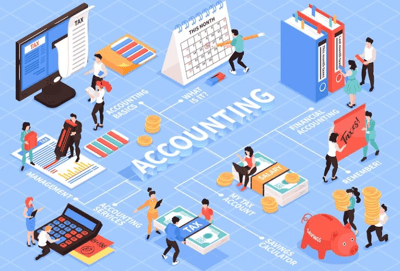Understanding the Role of Accounts Receivable: Permanent or Temporary?

Accounts receivable (AR) is a vital component in a business's financial performance, representing the money owed by customers for goods or services provided. Understanding the nature of AR and its effect on financial statements is crucial for business owners. Efficient management of AR impacts cash flow while monitoring the average collection period helps assess the effectiveness of receivables management.
Additionally, for the purpose of creating correct financial statements, it is crucial to know the distinctions between permanent and temporary accounts. Permanent accounts reflect a business's long-term economic health, while temporary accounts capture short-term performance. In summary, grasping these ideas is essential to making wise decisions and running a successful business.
1. Types of Accounts: Permanent and Temporary

The term "permanent accounts" refers to those still open at the conclusion of the accounting period and carry over their balances into the subsequent one. Accounts for assets, liabilities, and equity are a few of these. Temporary accounts, on the other hand, are those that are shut down at the conclusion of the accounting period and have their balances moved to the retained earnings account. These accounts contain profit and loss accounts and revenue and spending accounts.
Accounts for assets, liabilities, and equity are a few of these. These accounts are not closed at the conclusion of the accounting period because the balance is carried forward from one accounting period to the next. Examples of permanent statements include cash, funds payable, and owner's equity. Contrarily, temporary accounts are ones that are closed at the end of the accounting period.
These accounts contain profit and loss accounts and revenue and spending accounts. Through a closing entry, the remaining money is moved from these accounts to the retained earnings account. Sales receipts, the cost of products sold, and payroll costs are a few examples of temporary arrangements.
For sole proprietorship and other enterprises, it's crucial to comprehend the distinction between permanent and temporary accounts. Sole proprietors use these accounts to track their business activities and monitor their financial performance. They can use permanent accounts to calculate the total value of their business, while temporary accounts help them analyze their economic activity over a specific period.
Finally, it should be noted that both permanent and temporary accounts are crucial to the accounting process. They help businesses monitor their financial activity and prepare accurate financial statements. Understanding the difference between these types of accounts is vital for sole proprietors and other companies to effectively manage their finances.
2. The Accounting Process

The accounting process involves recording financial transactions and maintaining financial records to prepare financial statements. The procedure entails entering transactions in a journal, publishing them to a ledger, creating a trial balance, entering corrective entries, and creating an income statement and balance sheet.
The closing process involves closing temporary accounts to the retained earnings account. The accounting process involves several stages, including:
- Recording Financial Transactions - This involves documenting all revenue, expenses, assets, and liabilities in a journal.
- Posting Financial Transactions - Following the recording of financial transactions, the general ledger must be updated. The public ledger is a record of all accounts used by a business, and it includes both permanent and temporary accounts.
- Making a Trial Balance - The following step is to produce a trial balance after financial transactions have been entered into the general ledger. This report summarizes the balances of all accounts in the public ledger.
- Making Adjusting Entries - After preparing the trial balance, the next step is to adjust entries. These entries are used to update account balances to accurately reflect the current financial situation of the business.
- Creating Financial Statements - Following the completion of all adjustment entries, financial statements need to be started.
- Closing Temporary Accounts - Closing all temporary accounts and moving their amounts to the retained earnings account completes the accounting process. The accounting process is a crucial part of financial management for businesses of all sizes.
It enables business owners to keep tabs on their financial situation and to make wise choices on the direction of their company. For effective financial management, it is crucial to comprehend the processes in the accounting process.
3. Examples Of Both Transient And Long-Term Accounts

After discussing the distinctions between temporary and permanent accounts, let's examine an example of both.
-
Temporary Account Example
Example of a temporary account: Take into mind that you are the manager of A Super Mart and that you close your temporary accounts at the conclusion of every fiscal year.
In 2021, your business made sales of $50,000. However, you failed to close the temporary account, and as a result, the $50,000 balance carried over into 2022. In 2022, your business made $70,000, but due to the remaining balance from the previous year, the total sales would appear as $120,000.
You must move any residual balance from temporary accounts to permanent accounts at the beginning of each year in order to prevent this situation from occurring.
This way, you can accurately measure your sales each year and prevent discrepancies in financial reporting. Revenue accounts, cost accounts, and loss accounts are a few examples of temporary accounts, and it's crucial to close them at the conclusion of each fiscal period to maintain accurate financial statements.
Businesses may monitor their financial performance and make wise decisions for future growth by managing temporary account balances effectively.
-
A Permanent Account Example
If your cash account ends with $30,000 at the end of 2021, you must transfer this amount to your 2022 starting balance as it is a permanent account.
In 2022, you add another $25,000 to your cash account, bringing the year-end balance to $55,000. This balance will carry over to 2023 as your starting balance. Permanent account balances will be carried forward each year until you no longer use them (for instance, when your business closes). For tracking a company's long-term financial position, managing permanent accounts is essential.
Asset, liability, and equity accounts are only a few examples of the various types of permanent accounts. These accounts represent the financial position of the business, and their balances are carried forward from one fiscal period to the next.
By carrying forward permanent account balances correctly, businesses can monitor their financial health and make informed decisions for future growth.
4. The Role of Accounts Receivable in Financial Statements

Accounts Receivable is a critical aspect of a company's financial statements that reflects the expected payment from customers in the near future. As a current asset, it's essential to monitor the balance of the Accounts Receivable account regularly. A high ratio of Accounts Receivable can indicate that the business relies too heavily on credit sales or that customers are not paying their debts on time. This can harm the cash flow and financial stability of the company.
A company's Accounts Receivable balance affects its working capital, the money available to fund day-to-day operations. To maintain positive working capital, businesses need to ensure that they have sufficient cash flow to meet their obligations.
The average collection period, the amount of time it takes for a company to collect payment from its customers, is a crucial metric for businesses to track. A high average collection period can indicate that the business is not efficiently managing its accounts receivable, resulting in cash flow problems.
Business owners can take steps to manage their accounts receivable, such as offering incentives for early payments, using reliable payment processing software, and using credit checks to screen potential customers. Proper management of accounts receivable can help improve cash flow, enhance financial stability, and ensure the long-term success of a business.
Monitoring the balance of the Accounts Receivable account and the average collection period is essential for business owners to assess the financial health of their organization. Proper management and accounts receivable software can help improve cash flow, enhance financial stability, and ensure the long-term success of a business.
5. Manual Accounting Systems vs. Accounting Software

Manual accounting systems require a time-consuming process of recording transactions in a journal and transferring them to a ledger. The extended period of recording transactions and reconciling accounts can be a challenge for small businesses. Accounting software automates the entire process and provides financial reports in real time.
Businesses once tracked their financial activities using manual accounting methods. These systems involved a time-consuming process of recording transactions in a journal and transferring them to a ledger. However, many organizations have shifted to automated procedures due to the development of accounting software.
In this section, we will compare manual accounting systems with accounting software and explore their advantages and disadvantages.
-
Manual accounting systems
Manual accounting systems require a significant amount of time to record transactions and reconcile accounts. It involves a high risk of human error and can lead to discrepancies in financial reports. However, manual systems are less expensive than automated systems and do not require extensive training or technical expertise.
-
Accounting Software
On the other hand, accounting software automates the entire accounting process and provides financial reports in real time. It ensures precise financial reporting and lowers the possibility of human error. Accounting software also provides a centralized database of financial records, making it easier for businesses to monitor their economic activities.
However, accounting software can be pricey and challenging to use without technical knowledge. To maintain the best functioning, it also needs frequent upgrades and maintenance. Additionally, businesses may need to invest in hardware and IT infrastructure to support the software.
Both manual accounting systems and accounting software have their advantages and disadvantages. Choosing the right plan for a business depends on several factors, including the size of the company, the complexity of its financial activities, and its budget.
While manual systems may be suitable for small businesses with simple financial activities, companies with complex economic activities may benefit from using good accounting software.
6. Permanent Account Balances vs. Temporary Account Balances

Permanent account balances persist across accounting periods, while temporary account balances are settled after each fiscal period. Making accurate financial statements requires being able to distinguish between permanent and temporary accounts.
Permanent accounts embody the long-standing financial condition of a business, and their balances continue from one fiscal period to another. Cash, accounts receivable, accounts payable, and owner's equity are examples of such accounts. Conversely, temporary accounts evaluate a business's performance over a specific fiscal period.
After each period, the balances of these accounts are closed and transferred to the retained profits account. Sales revenues, cost of goods sold, and wages expenses are some examples of temporary arrangements. Grasping the differences between permanent and temporary account balances is vital for accurate financial statement preparation.
Permanent account balances demonstrate the enduring financial position of a company, while temporary account balances showcase short-term financial performance. Tax accounts, which represent the taxes owed or prepaid by a business, are also considered permanent accounts, as their balances carry forward from one period to the next.
Accurate financial reporting necessitates a clear understanding of permanent versus temporary account balances. Permanent accounts depict a business's long-term financial standing, whereas provisional statements reflect its short-term economic achievements.
Permanent accounts encompass asset, liability, and equity accounts, while temporary accounts include revenue, expense, and loss accounts. Endless statements also have tax accounts.
In summary, distinguishing between permanent and temporary account balances is crucial for accurate financial reporting. Permanent accounts represent the long-term financial health of a business, while temporary accounts measure short-term financial performance.
Balances in permanent accounts, such as assets, liabilities, and equity, persist across accounting periods. In contrast, temporary account balances, including revenues, expenses, and losses, are closed at the end of each fiscal period. Tax accounts, as another example of permanent funds, also carry their balances forward from one period to the next.
The Takeaway
In conclusion, accounts receivable software play a pivotal role in a business's accounting cycle, significantly influencing cash flow and necessitating professional management. Regularly monitoring the average collection period enables evaluation of receivables efficiency, with a shorter duration indicative of superior cash flow and minimized terrible debt risk.
Comprehending the distinctions between permanent and temporary accounts is imperative for creating precise financial statements. Permanent arrangements showcase a business's long-term financial stability, while temporary accounts capture short-term performance fluctuations. Mastering these concepts facilitates the production of accurate financial statements, fostering data-driven decision-making and bolstering long-term success for the organization.

